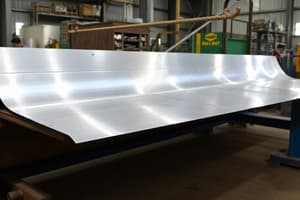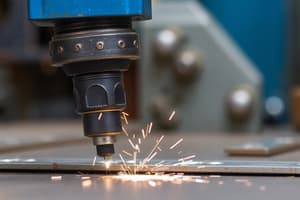Podcast
Questions and Answers
The penetration zone during the punching operation is approximately one-half the thickness of the sheet.
The penetration zone during the punching operation is approximately one-half the thickness of the sheet.
False (B)
During the punch operation, compression of the sheet occurs as the punch moves downward.
During the punch operation, compression of the sheet occurs as the punch moves downward.
True (A)
Warm working occurs when the stock is thick.
Warm working occurs when the stock is thick.
True (A)
Brittle metal is more suitable for hot working than warm working.
Brittle metal is more suitable for hot working than warm working.
The penetration that occurs during the cutting operation does not involve any compression of the material.
The penetration that occurs during the cutting operation does not involve any compression of the material.
Cutting operations are characterized by a punch moving horizontally through the sheet.
Cutting operations are characterized by a punch moving horizontally through the sheet.
Significant deformation is a factor that suggests warm working instead of hot working.
Significant deformation is a factor that suggests warm working instead of hot working.
Penetration into the metal occurs before the cutting action begins.
Penetration into the metal occurs before the cutting action begins.
Hot working is preferable when dealing with brittle metal.
Hot working is preferable when dealing with brittle metal.
When the metal is brittle, it is an exception that favors the use of hot working methods.
When the metal is brittle, it is an exception that favors the use of hot working methods.
Fracture is initiated in the work at one cutting edge of the punch.
Fracture is initiated in the work at one cutting edge of the punch.
V-bending allows for the creation of angles that are exclusively acute.
V-bending allows for the creation of angles that are exclusively acute.
The punch travels into the work only to create a single fracture line.
The punch travels into the work only to create a single fracture line.
The two fracture lines do not meet if the clearance is incorrect.
The two fracture lines do not meet if the clearance is incorrect.
A punch that effectively separates the work will create multiple pieces regardless of clearance.
A punch that effectively separates the work will create multiple pieces regardless of clearance.
A correct clearance between the punch and die allows for clean separation of the work.
A correct clearance between the punch and die allows for clean separation of the work.
V-dies associated with V-bending are complex and costly.
V-dies associated with V-bending are complex and costly.
V-bending is typically utilized for high-production operations.
V-bending is typically utilized for high-production operations.
The process of V-bending is commonly performed on a press brake.
The process of V-bending is commonly performed on a press brake.
V-bending can only produce angles up to 90 degrees.
V-bending can only produce angles up to 90 degrees.
Wiping dies are more simple and less expensive than V-dies.
Wiping dies are more simple and less expensive than V-dies.
Wiping dies are generally used for low-production work.
Wiping dies are generally used for low-production work.
The pressure pad contributes to the complexity and cost of wiping dies.
The pressure pad contributes to the complexity and cost of wiping dies.
V-dies are typically the choice for high-production work.
V-dies are typically the choice for high-production work.
Cost and complexity are characteristics associated with wiping dies.
Cost and complexity are characteristics associated with wiping dies.
Sheet metal is only bent, not stretched, in the stretch forming process.
Sheet metal is only bent, not stretched, in the stretch forming process.
The process of stretch forming can be used to create complex shapes from sheet metal.
The process of stretch forming can be used to create complex shapes from sheet metal.
Stretch forming is a technique exclusively used for plastic materials.
Stretch forming is a technique exclusively used for plastic materials.
In stretch forming, the metal is both stretched and bent at the same time.
In stretch forming, the metal is both stretched and bent at the same time.
Stretch forming can only be applied to thin gauges of metal.
Stretch forming can only be applied to thin gauges of metal.
Flashcards
Punch Penetration
Punch Penetration
The area where the punch compresses and cuts the sheet metal during a cutting operation.
Penetration Depth
Penetration Depth
Approximately one-third the thickness of the sheet metal.
Sheet Metal Cutting
Sheet Metal Cutting
The process of using a punch to create a hole of controlled depth.
Punch Compression
Punch Compression
Signup and view all the flashcards
Cutting Operation
Cutting Operation
Signup and view all the flashcards
Exceptions to stock thickness
Exceptions to stock thickness
Signup and view all the flashcards
Warm working vs. hot working
Warm working vs. hot working
Signup and view all the flashcards
Stock thickness
Stock thickness
Signup and view all the flashcards
Metal brittleness
Metal brittleness
Signup and view all the flashcards
Significant deformation
Significant deformation
Signup and view all the flashcards
Fracture initiation
Fracture initiation
Signup and view all the flashcards
Cutting edges
Cutting edges
Signup and view all the flashcards
Punch and die clearance
Punch and die clearance
Signup and view all the flashcards
Clean separation
Clean separation
Signup and view all the flashcards
Fracture lines
Fracture lines
Signup and view all the flashcards
V-dies
V-dies
Signup and view all the flashcards
V-bending
V-bending
Signup and view all the flashcards
Press Brake
Press Brake
Signup and view all the flashcards
Low-production operations
Low-production operations
Signup and view all the flashcards
Inexpensive V-dies
Inexpensive V-dies
Signup and view all the flashcards
Stretch Forming
Stretch Forming
Signup and view all the flashcards
Sheet Metal
Sheet Metal
Signup and view all the flashcards
Simultaneous
Simultaneous
Signup and view all the flashcards
Shape
Shape
Signup and view all the flashcards
Achieve
Achieve
Signup and view all the flashcards
Wiping Dies
Wiping Dies
Signup and view all the flashcards
Pressure Pad
Pressure Pad
Signup and view all the flashcards
High-production Work
High-production Work
Signup and view all the flashcards
Costly
Costly
Signup and view all the flashcards
Study Notes
Production Technology: Sheet Metal Working
- Sheet metal working involves cutting and forming operations on thin sheets of metal
- Typical sheet metal thickness ranges from 0.4mm to 6mm
- Metal stock thicker than 6mm is typically referred to as plate, not sheet
- Sheet metal processing is usually performed at room temperature (cold working)
- Exceptions include thick stock, brittle metals, and significant deformation, which often involve warm working instead of cold working
Sheet Metal Working Terminology
- "Punch-and-die": Tooling for cutting, bending, and drawing sheet metal
- "Stamping press": Machine tool performing most sheet metal operations
- "Stampings": Sheet metal products
Advantages of Sheet Metal Parts
- High strength
- Good dimensional accuracy
- Good surface finish
- Relatively low cost
- Economical mass production for large quantities
Cutting Operations
- Sheet metal cutting uses shearing between sharp cutting edges
- Plastic deformation of the sheet occurs as the punch enters the work
- Penetration occurs during downward movement, compressing the sheet and cutting into the metal
- The penetration zone is generally one-third the thickness of the sheet
- Fracture initiates at the cutting edges, resulting in a clean separation if clearance is correct
Steps of Shearing
- Just before punch contact, initial state of the work
- Punch pushing into the work causes plastic deformation
- Punch compresses and penetrates to create a smooth cut surface
- Fracture occurs at opposing edges separating the sheet
Shearing, Blanking, and Punching
- These are the three main shearing operations in press working
- Shearing: Cutting along a straight line between two edges, often for preparing larger sheets for further press operations using power shears or squaring shears. The upper shear blade is angled to decrease cutting force.
- Blanking: Single-step cutting of a closed outline from a sheet to create a part (blank)
- Punching: Similar to blanking but creates a hole, separating a piece of sheet metal creating the scrap, called the slug. The remaining sheet is the desired part
Bending Operations
- Bending in sheet metal work refers to straining metal around a straight axis
- Metal on the inside of the neutral plane is compressed during bending, while metal on the outside is stretched
- Bending typically causes little to no change in the sheet's thickness
Types of Sheet Metal Bending
- V-Bending: Uses a V-shaped die, suitable for obtuse to acute angles, commonly used for lower production and often performed on a press brake
- Edge Bending: Uses a wiping die, suitable for angles of 90° or less, more complex than V-bending, costly but for higher production
Drawing
- Drawing is a sheet metal operation used to make cup, box or concave shaped parts (e.g., cans, cooking pots, automotive panels).
Redrawing
- Redrawing is used when a single drawing stage isn't enough for parts with significant shape changes and severe drawing ratios
- It involves multiple drawing steps after the first
Sheet-Metal Operations Not Performed On Presses
- Stretch Forming: Stretching and bending sheet metal simultaneously to achieve shape change
- Roll Bending: Shaping large sheets or plates into curved sections using rolls
- Spinning: Forming basic geometric shapes (cups, cones, tubes) by rotating a sheet on a mandrel
Studying That Suits You
Use AI to generate personalized quizzes and flashcards to suit your learning preferences.




